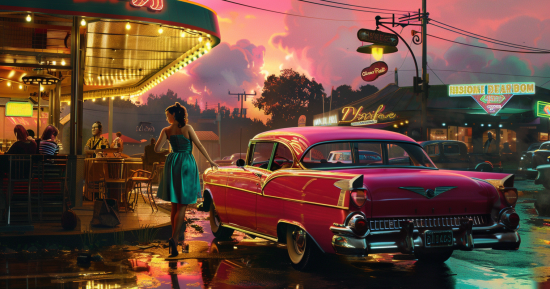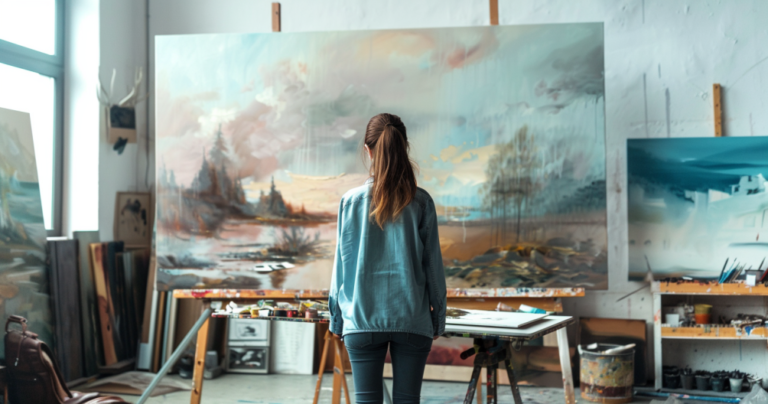Winter is the perfect time to dive into painting. Imagine creating your snowy landscapes or capturing the cozy feeling of a warm fire on canvas. At this time of year, inspiration is everywhere, from the frosty window patterns to the soft colors of a winter sunset.
You don’t need to be a professional artist to make something beautiful. You can create something truly special by experimenting with different techniques and subjects. Unique winter paintings are about capturing the season’s essence in your style. Whether using acrylics, watercolors, or pastels, every brushstroke can help tell a story.
Winter Painting Unique
There’s something magical about winter that makes it an ideal subject for painters. Explore different themes like peaceful snow-covered scenes or the rich textures found in nature. Your winter art can become a wonderful expression of the season’s beauty by tapping into your creativity.
Inspiration Behind Winter Paintings
Historical Context of Winter Landscapes
During the Middle Ages, artists began to depict winter scenes, finding inspiration in the season’s stark contrasts and quiet simplicity. The fascination with how light interacts with snow has driven many painters to explore winter themes.
In the 19th century, artists like Pieter Bruegel the Elder captured everyday life amid cold settings, offering a glimpse into the past. These historical pieces provide insight into how winter was experienced centuries ago, and their influence is still seen today.
Famous Winter Scenes in Art History
Some of the most renowned winter paintings come from artists like Claude Monet and Pieter Bruegel the Elder.
Monet’s piece, The Magpie, showcases his skill in capturing light and shadow on snow, while Bruegel’s works often focus on lively winter activities in villages.
These artists highlight winter’s many moods, from quiet and serene to bustling and vibrant. Viewing these famous scenes helps to appreciate the depth and variation in winter art through the ages, each offering a unique and compelling perspective.
Techniques for Creating Winter Scenes
Choosing the Right Palette
When painting winter scenes, choose a color palette that captures the chilly atmosphere. Cool blues and whites are often used to depict snow and ice. Add some soft grays and purples for shadows and depth.
Include warm colors sparingly. Splashes of red, orange, or yellow can symbolize sunlight or warmth, breaking the monotony of more fabulous shades. These colors can highlight small details like a scarf or a distant cabin.
Try blending colors on your palette before applying them. This creates gradients and transitions that mimic a winter landscape’s soft, blended look. Your goal is to convey the crispness and serenity of winter through thoughtful color choices.
Texture and Brushwork for Snow
The texture is key when painting snow. Creating the fluffy, powdery look of fresh snow requires specific brushwork. Experiment with different brushes to achieve the right effect.
Use a round or fan brush and apply light, dabbing strokes to create a snow-laden scene. Palette knives are also helpful. They help you thickly layer paint to mimic snowbanks’ uneven, textured appearance.
Impasto techniques can add dimension, making your snow appear more realistic. Apply the paint thickly, letting it stand out from the canvas. This technique can give viewers the illusion that they can almost touch the snowy surface.
Capturing Light and Shadows
Winter scenes often have a unique play of light and shadow. The sun’s low angle creates long, dramatic shadows, emphasizing textures and forms.
Observe how the light reflects on snow, often creating a bright white surface with blue or purple shadows beneath. Use light to add contrast, bringing elements of your painting into focus.
Experiment with highlights and reflections. Light can bounce off icy patches, adding sparkle and life to your work. To add depth and interest, capture how sunlight filters through bare branches or shadows that stretch across a snowy field.
Frequently Asked Questions – Winter Painting Unique
What are some beginner-friendly techniques for creating a unique winter painting?
For beginners, starting with simple techniques like layering and dry brushing can be helpful. Using basic colors and gradually adding details makes the process manageable. Try experimenting with different textures to make your painting stand out.
Which surfaces are best for painting a winter scene uniquely on canvas?
Canvas is a great choice, but textured papers or wooden panels also work well. These surfaces can add depth to your painting and help you achieve unique effects. Each surface can change how your paint looks and feels.
How can I make an easy yet unique winter painting?
Focus on simple elements like snowflakes and bare trees. Use a limited color palette to create contrast. Incorporate different materials like salt to add interesting patterns and textures.
Can you suggest some creative winter painting ideas that stand out?
Consider painting abstract winter landscapes or whimsical snow creatures. Using unusual color combinations or unexpected textures can make these paintings pop. Adding metallic paints or glitter can create eye-catching highlights.





